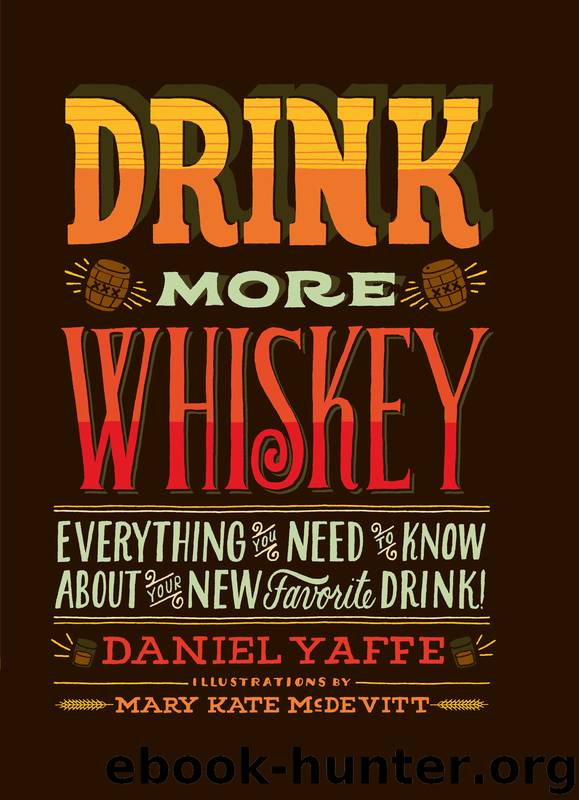Drink More Whiskey by Daniel Yaffe

Author:Daniel Yaffe
Language: eng
Format: epub
Publisher: Chronicle Books LLC
Published: 2013-12-30T16:00:00+00:00
Sir Mix-a-Iot
If making whisky is chemistry, blending is an art. The vast majority of the Scotch imbibed around the world is blended. A blended Scotch can be made from malted barley with any other grains and can be a mixture of whiskies from any number of distilleries. With the arrival of technological innovations around 1830 that allowed for quick mass production of lighter grain whisky, blends proved to be a much cheaper way to make shiploads of whisky. A large industrial grain distillery can make as much whisky in a week as a small malt distillery like TALISKER makes in a year. Grain spirits make up the base of blended Scotches (usually anywhere from 10 to 70 percent of the mix), and single malts add most of the flavor to the end product. Grain whisky is the canvas, and malt whisky is the paint that creates the picture. As a general rule, production techniques result in lighter grain blends with less intense flavors than their single-malt counterparts. That’s why you may have seen connoisseurs snub their noses at blends. Approach them with an open mind. They can sometimes surprise you.
Back in the day, when booze was mostly sold at local grocery stores in Scotland, customers would fill up their ceramic jars from a cask of whisky. Somewhere between the bushels of peas and the mounds of chicken gizzards, grocers in the countryside started making blended whiskies. The most famous blender was a boy named Johnnie Walker, who got his start mixing teas at his family’s market. He later started playing around with the barrels of whisky at the shop, mixing them into his own creations. Blending whiskies was a way for him and other grocers to give customers more consistency and offer their own twist on local booze. Johnnie’s Scotch has been selling since the early 1800s, and after he purchased a few distilleries to supply whisky for his blends, the Walker family led the brand for decades of impressive growth. Fueled by a brilliant marketing campaign and international fame, the eponymous blends are still among the top-selling whiskies of the world. Some of the current JOHNNIE WALKER labels are made with a mix of up to fifty different whiskies. You’ll never know the entire makeup of any blends because the brands don’t want them copied, but know that they were a very intentional mix of tastes on the part of the blenders. Using fifty-plus distilleries also ensures consistency. A distiller making a single malt has a narrow color wheel of whiskies from one distillery, but blenders don’t need to limit themselves, as they can work with a much wider spectrum of flavors. If a single malt is a group of violinists with a brilliant tone, a blend might be the full orchestra. By following a recipe of barrels from different distilleries, blenders are trained to make massive quantities that match the taste of the batch that preceded it. It’s the blender’s job to ensure that your whisky tastes identical bottle to bottle, no matter where you drink it.
Download
This site does not store any files on its server. We only index and link to content provided by other sites. Please contact the content providers to delete copyright contents if any and email us, we'll remove relevant links or contents immediately.
| Buying Guides | Cellars |
| Champagne | Collecting |
| Spirits | Whiskey |
| Wine | Wine Pairing |
| Wine Tasting |
Whiskies (Collins Gem) by dominic roskrow(42214)
101 Whiskies to Try Before You Die by Ian Buxton(42182)
Whiskies Galore by Ian Buxton(40332)
Craft Beer for the Homebrewer by Michael Agnew(17447)
Right Here, Right Now by Georgia Beers(3497)
Not a Diet Book by James Smith(2726)
Water by Ian Miller(2584)
The Coffee Dictionary by Maxwell Colonna-Dashwood(2531)
Kitchen confidential by Anthony Bourdain(2306)
Coffee for One by KJ Fallon(2008)
Smuggler's Cove: Exotic Cocktails, Rum, and the Cult of Tiki by Martin Cate & Rebecca Cate(1979)
Beer is proof God loves us by Charles W. Bamforth(1920)
Superfood Smoothie Bowls: Delicious, Satisfying, Protein-Packed Blends that Boost Energy and Burn Fat by Chace Daniella(1903)
Talking as Fast as I Can by Lauren Graham(1832)
Bourbon: A Savor the South Cookbook by Kathleen Purvis(1791)
A Short History of Drunkenness by Forsyth Mark(1720)
Eat With Intention by Cassandra Bodzak(1688)
Cocktails for the Holidays by Editors of Imbibe magazine(1626)
Colombia Travel Guide by Lonely Planet(1609)
